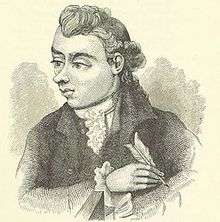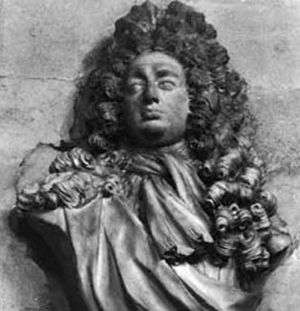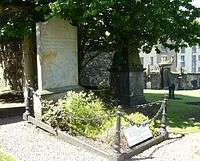Robert Fergusson

Robert Fergusson (5 September 1750 – 16 October 1774) was a Scottish poet. After formal education at the University of St Andrews, Fergusson led a bohemian life in Edinburgh, the city of his birth, then at the height of intellectual and cultural ferment as part of the Scottish enlightenment. Many of his extant poems were printed from 1771 onwards in Walter Ruddiman's Weekly Magazine, and a collected works was first published early in 1773. Despite a short life, his career was highly influential, especially through its impact on Robert Burns. He wrote both Scottish English and the Scots language, and it is his vivid and masterly writing in the latter leid[1] for which he is principally acclaimed.
Life

Robert Fergusson was born in Cap and Feather Close, a vennel off Edinburgh’s Royal Mile, later demolished to make way for what is today the southern abutment of the North Bridge. His parents, William and Elizabeth (née Forbes), were originally from Aberdeenshire, but had moved to the city two years previously. He was the third of three surviving children by them. He received formal schooling at the city's Royal High School and the High School of Dundee, leading to matriculation into the University of St Andrews with the assistance of a clan Fergusson bursary in 1765.
In May 1768 Fergusson returned to Edinburgh. His father had died the previous year, his sister Barbara had married, and his older brother Harry had recently left Scotland, enlisting with the Royal Navy after a business failure. This probably left Fergusson, who had not completed his studies, to support their mother. Any possibility of family support from his maternal uncle, John Forbes of Round Lichnot near Auld Meldrum, ceased when his uncle permanently disowned him after a quarrel. Fergusson, who had rejected the church, medicine and law as career options open to him due to his university training, finally settled in Edinburgh as a copyist, the occupation of his father.
Literary career

There is good evidence that Fergusson had already been developing literary ambitions as a student at St Andrews where he claimed to have begun drafting a play on the life of William Wallace. His earliest extant poem, also written at this time, is a satirical elegy in Scots on the death of David Gregory, one of the university’s professors of maths.
Fergusson involved himself in Edinburgh's social and artistic circles mixing with musicians, actors, artists and booksellers who were also publishers. His friend, the theatre-manager William Woods, regularly procured him free admission to theatre productions[2] and in mid-1769 Fergusson struck up a friendship with the Italian castrato singer Giusto Fernando Tenducci, who was touring with a production of Artaxerxes. Fergusson's literary debut came when Tenducci asked him to contribute Scots airs for the Edinburgh run of the opera. Fergusson supplied three, which were performed and published with the libretto.
After February 1771 he began to contribute poems to Walter Ruddiman's Weekly Review. These at first were generally conventional English language works that were either satirical or fashionably pastoral in the manner of William Shenstone. His first Scots poem to be published (The Daft Days) appeared on 2 January 1772, and from that date on he submitted works in both languages.
Popular reception for his Scots work, as evidenced in a number of verse epistles in its praise,[3] helped persuade Ruddiman to publish a first general edition of his poems which appeared in early 1773 and sold around 500 copies, allowing Fergusson to clear a profit.[4]
In mid-1773 Fergusson attempted his own publication of Auld Reekie, now regarded as his masterpiece, a vivid verse portrait of his home city intended as the first part of a planned long poem. It demonstrated his ambition to further extend the range of his Scots writing. This also included an aspiration to make Scots translations of Virgil's Georgics, thus following in the footsteps of Gavin Douglas. However, if any drafts for such a project were made, none survive. The poet was a hard self-critic and is known latterly to have destroyed manuscripts of his writing.[5]
Clubs
Fergusson was a member of the Cape Club which regularly assembled at a tavern in Craig's Close. Each member had a name and character assigned to him, which he was required to maintain at all gatherings. David Herd (1732–1810), the collector of the classic edition of Ancient and Modern Scottish Songs (1776), was "sovereign" of the Cape (in which he was known as "Sir Scrape") when Fergusson was dubbed a knight of the order, with the title of "Sir Precentor", in allusion to his fine voice. Alexander Runciman, the historical painter, his pupil Jacob More, and Sir Henry Raeburn were all members. The old minute books of the club abound with pencilled sketches by them, one of the most interesting of which, ascribed to Runciman, is a sketch of Fergusson in his character of "Sir Precentor".
Death

Fergusson's literary energy and active social life were latterly overshadowed by what may have been depression although there are likely to have been other factors. From around mid-1773 his surviving works appear to become more darkly melancholic. In late 1773, in his "Poem to the Memory of John Cunningham" which was written on hearing news of the death of that poet in an asylum in Newcastle, Fergusson expressed fears of a similar fate.[6]
His fears were founded. Around the backend of the year 1774, after sustaining a head injury in circumstances that are obscure (he fell heavily down a flight of stairs in Edinburgh, according to his epitaph), Fergusson was submitted against his will into Edinburgh's Darien House "hospital" (close to today's eponymous Bedlam Theatre), where, after a matter of weeks, he suddenly died. He had only just turned 24. He was buried in an unmarked grave on the west side of the Canongate Kirkyard.

The poet Robert Burns privately commissioned and paid for a memorial headstone of his own design, which was erected in 1787. In the later nineteenth century, Robert Louis Stevenson intended to renovate the stone, but died before he could do so. The epitaph that Stevenson planned to add to the stone is recorded on a plaque added to the grave by the Saltire Society on the Society's 50th anniversary in 1995.
Memorials
Fergusson is one of the sixteen Scottish poets and writers depicted on the lower section of the Scott Monument on Princes Street. He appears on the right side of the west face, opposite Robert Burns.
A plaque was erected in his memory in St Giles Cathedral in the 1930s.
An independent statue outside Canongate Churchyard was unveiled on 17 October 2004, following a competition for a memorial to Fergusson. The sculptor was David Annand.[7][8]
Questions about the life and work of Fergusson were answered as a specialist subject on an edition of Mastermind on BBC2 broadcast on 25th September 2015.
Overview and influence
Fergusson's literary output was both urban and pastoral in equal degree. He was often an effective satirist and generally nationalist in themes and outlook. Although small, his canon stands as an important artistic and linguistic bridge between the generation of Allan Ramsay (1686–1758) and most later writers in Scots. His bilingual career was the acknowledged inspiration for the career of Robert Burns. Many leading makars of the twentieth century, such as Robert Garioch or Sydney Goodsir Smith, similarly recognised his importance. More widely, however, his legacy has tended to be unjustly neglected.
Many works by Burns either echo or are directly modelled on works by Fergusson. For example, "Leith Races" unquestionably supplied the model for Burns' "Holy Fair". "On seeing a Butterfly in the Street" has reflections in it which strikingly correspond with "To a Mouse". Comparisons, such as between Fergusson's "The Farmer's Ingle" and Burns' "The Cottar's Saturday Night", often demonstrate the creative complexity of the influence.
Fergusson's life also had one important non-literary influence. The brutal circumstances of the poet's death prompted one of his visitors in Darien House, the young doctor Andrew Duncan (1744–1828), to pioneer better institutional practices for the treatment of mental health problems through the creation of what is today the Royal Edinburgh Hospital.[9]
Editions
Ruddiman's 1773 edition of Fergusson's work was reprinted in 1779 with a supplement containing additional poems. A second edition appeared in 1785. There are later editions, by Robert Chambers (1850) and Alexander Grosart (1851). A life of Fergusson is included in David Irving's Lives of the Scottish Poets, and in Robert Chambers's Lives of Illustrious and Distinguished Scotsmen. Grosart also contributed a biography of Fergusson for the "Famous Scots Series", (Edinburgh: Oliphant, Anderson and Ferrier, 1898).
See also
External links
- Robert Fergusson Society
- Portrait of Fergusson by Alexander Runciman in the National Gallery of Scotland
- Robert Fergusson is commemorated in Makars' Court outside The Writers' Museum, Lawnmarket, Edinburgh. Selections for Makars' Court are made by The Writers' Museum, The Saltire Society and The Scottish Poetry Library.
References
| Wikimedia Commons has media related to Robert Fergusson. |
- ↑ SND: Leed
- ↑ Matthew McDiarmid, The Poems of Robert Fergusson (2 vols), Volume 1. Blackwood, 1954, pp. 22-28.
- ↑ See Robert Fergusson Selected Poems, edited by James Robertson (Edinburgh: Birlinn, 2000). Examples are by "J.S.", published 3 September 1772 (pp. 68-70), and Andrew Gray, published 11 June 1773 (pp. 139-40). Fergusson himself wrote Scots verse epistles in reply to both.
- ↑ Carol McGuirk: "The 'Rhyming Trade': Fergusson, Burns, and the Marketplace". In Heaven-taught Fergusson, ed. Robert Crawford, East Linton: Tuckwell Press, 2003. p. 117.
- ↑ Selected Poems, ed. Robertson (2000), pp. 22-6, discusses instances and possible reasons for this.
- ↑ Selected Poems, ed. Robertson (2000), p. 21.
- ↑ Statue of Robert Fergusson outside Canongate Kirk.
- ↑ David Annand website.
- ↑ http://www.nhslothian.scot.nhs.uk/aboutus/nhshistory/reh_history.asp